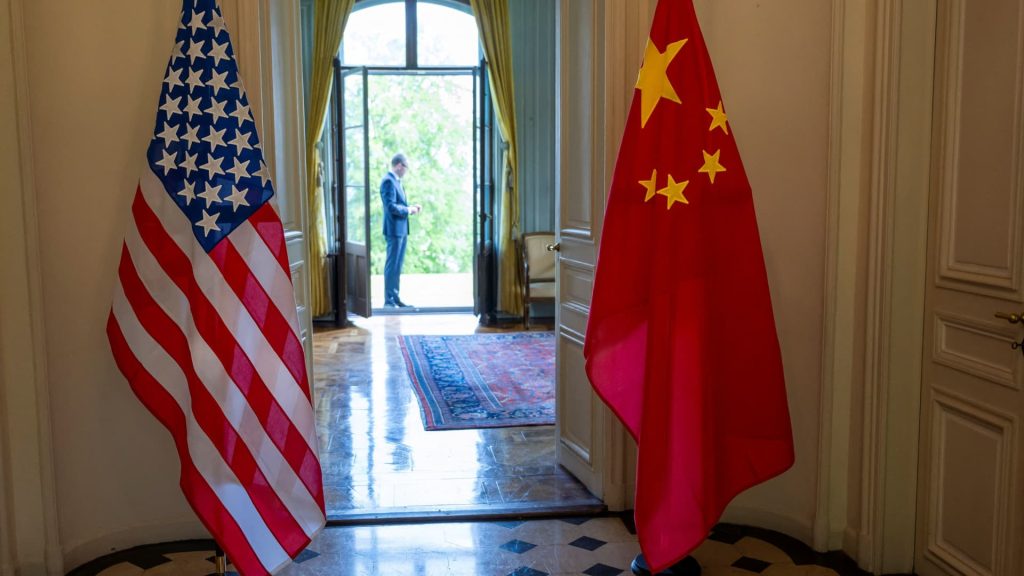In recent developments regarding U.S.-China relations, trade talks have become somewhat stalled, requiring direct communication between leaders from both nations. Treasury Secretary Scott Bessent has indicated that further discussions are anticipated within the upcoming weeks, with a potential call between U.S. President Donald Trump and Chinese President Xi Jinping on the horizon. Despite a recent breakthrough agreement in Switzerland, tensions remain, particularly concerning technology restrictions and rare earth export controls.
| Article Subheadings |
|---|
| 1) Current Status of U.S.-China Trade Talks |
| 2) Recent Trade Agreement in Switzerland |
| 3) Ongoing Tensions and Restrictions |
| 4) China’s Response to U.S. Actions |
| 5) Implications for Future Diplomatic Relations |
Current Status of U.S.-China Trade Talks
The ongoing trade negotiations between the United States and China are currently facing challenges, as both nations have yet to agree on key issues. U.S. Treasury Secretary Scott Bessent remarked that the discussions have reached a point of stagnation, necessitating direct communication between the presidents of both countries. During an interview, he indicated that there will likely be more talks in the near future, suggesting that a call could help address outstanding concerns and facilitate a smoother resolution.
These negotiations are critical, given the complexities involved in international trade and the economic interdependence of both nations. The stakes are high not only for the U.S. and China but also for the global economy, as any significant disruptions could reverberate across various markets and industries.
Recent Trade Agreement in Switzerland
On May 12, a breakthrough agreement was reached in Switzerland, marking a significant moment in U.S.-China trade relations. Following increased tensions in the prior month, the two countries agreed to roll back certain tariff increases of over 100% for a duration of 90 days, until mid-August. This agreement is intended to create a buffer period during which further negotiations can take place and hopefully yield more stable arrangements.
Bessent played a key role in facilitating this agreement and has expressed optimism regarding its potential impact. However, analysts highlight that while the rollback of tariffs is a positive development, it does not resolve the underlying structural issues contributing to trade friction between the two countries.
Ongoing Tensions and Restrictions
Despite the recent diplomatic efforts, significant tensions remain, particularly concerning technology restrictions and various export controls. The U.S. has continued to implement restrictions on specific high-tech sectors, a move that has frustrated the Chinese government. In response, China has maintained its stance on export controls for rare earth elements, critical materials used in technology manufacturing, which have become a flashpoint in the trade dispute.
Both nations are navigating a complex landscape marked by competing interests and differing economic philosophies. The ongoing tech rivalry contributes to a climate of distrust, necessitating careful diplomatic efforts to manage these tensions effectively.
China’s Response to U.S. Actions
China’s government has been vocal in its objections to U.S. policies regarding trade and technology. During a press briefing, Chinese Ministry of Commerce Spokesperson He Yongqian urged the U.S. to reconsider its approach, stating that the restrictions imposed on chip exports are detrimental to maintaining positive relations. She emphasized the importance of adhering to agreements reached during high-level talks in Geneva, suggesting that continued cooperation is paramount for mutual benefit.
Furthermore, when queried about the future of rare earth export controls, He did not directly answer, instead framing the issue as a matter of national security that aligns with international norms and practices. This reflects China’s strategic positioning in the ongoing economic competition, emphasizing its commitment to regional stability and peace.
Implications for Future Diplomatic Relations
The future of U.S.-China relations hinges on the ability of both nations to navigate these economic challenges collaboratively. The limitations imposed—such as the latest decision by the Trump administration to revoke visas for Chinese students—have drawn sharp criticism from Beijing, with officials labeling such measures as “unjustified” and motivated by ideological factors.
As both sides prepare for potential future discussions, analysts underscore the necessity for transparency and a willingness to negotiate openly. The outcomes of these talks could either lead to a thaw in relations or exacerbate existing tensions, impacting not only bilateral trade but also global market dynamics in various sectors, from technology to agriculture.
| No. | Key Points |
|---|---|
| 1 | U.S.-China trade talks are currently stalled, necessitating direct communication between leaders. |
| 2 | A recent breakthrough agreement was reached in Switzerland to roll back certain tariffs for 90 days. |
| 3 | Persistent tensions remain regarding technology restrictions and rare earth export controls. |
| 4 | China is urging the U.S. to reconsider its approach to trade restrictions and maintain open communications. |
| 5 | Future diplomatic ties will heavily depend on transparency and a commitment to negotiation from both sides. |
Summary
The evolving landscape of U.S.-China trade relations underscores the complexity of these two economies and their interdependence. As both parties prepare for potential future discussions, the outcome will determine the trajectory of their diplomatic relationship. Addressing key issues collaboratively is vital for fostering mutual trust and stability, which are essential for not only bilateral trade but also global economic health.
Frequently Asked Questions
Question: What is the significance of tariffs in U.S.-China trade?
Tariffs are taxes imposed on imports, affecting the cost of goods exchanged between countries. In U.S.-China trade, these tariffs can escalate tensions and lead to retaliatory measures, impacting economic relations.
Question: How do technology restrictions influence trade talks?
Technology restrictions can heighten tensions and complicate negotiations, as they often reflect national security concerns. These restrictions impact sectors that drive economic growth, making them a contentious issue in trade discussions.
Question: What is China’s stance on rare earth exports?
China emphasizes that restrictions on rare earth exports align with international practices and national security considerations. Rare earth elements are crucial for various industries, making this a key point in U.S.-China trade relations.
